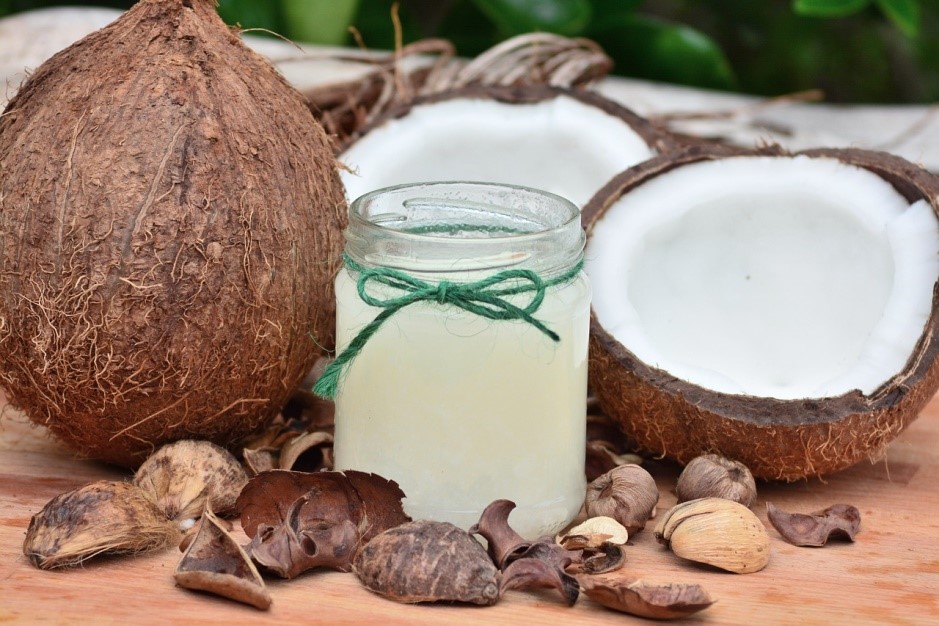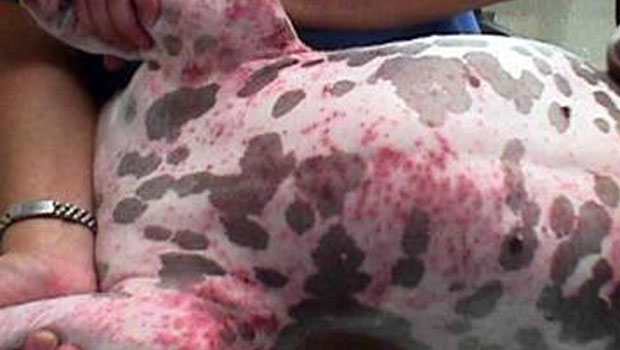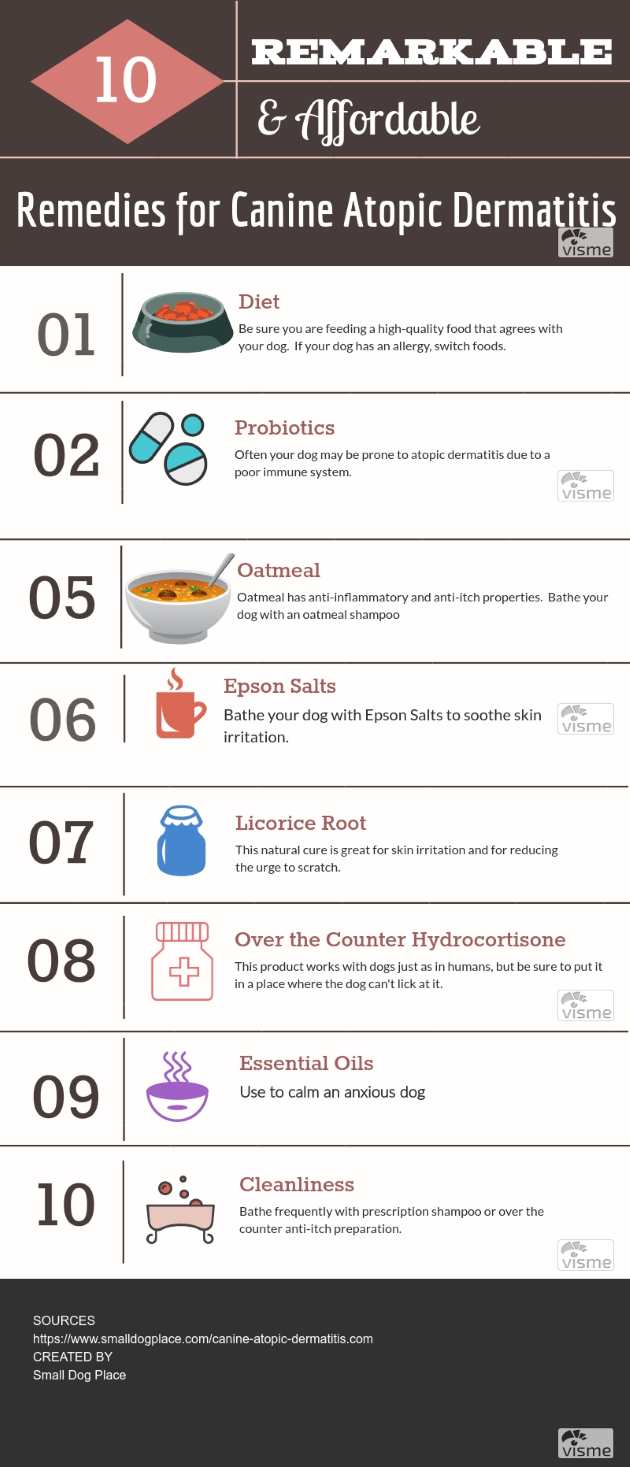- Small Dog Place Home
- Health
- Canine Atopic Dermatitis
Canine Atopic Dermatitis: 11 Remedies to Try
Canine Atopic Dermatitis by Rosie Tran |Updated 06-20-2022
One of the most frustrating issues about being a dog owner is when your dog suffers from some form of allergy.
One of the most common allergic ailments that your dog might suffer from is atopic dermatitis. Atopic dermatitis is usually provoked by common allergens that typically affect dogs in the environment.
Dogs are usually sensitive to environmental allergens like dust mites, fleas, pollen, and dander. This might leave you wondering if there is anything your dog is not allergic to.
Although allergies can affect any dog breed, Atopic Dermatitis is mostly genetic. Dogs with this condition should, therefore, not be bred.
Since this condition is genetic, many dog breeds have a predisposition to Atopy. These dog breeds include Miniature Schnauzers, English and Irish Setters, Labrador and Golden Retrievers, Shih Tzu, and Cairn Terriers.
When dogs suffer from this disease, they may start showing signs when they are between 3 months and 6 years of age.
However, sometimes Atopic Dermatitis may fail to become clinically apparent within your dog’s first three years. This is because it usually starts as a mild condition.
Symptoms of Canine Atopic Dermatitis
If your dog is suffering from this condition, then it will be easy for you to notice it once the symptoms have started to show. This is because the symptoms are often concentrated on a dog’s face, feet and underneath the front legs. These symptoms include:
- Chronic infection on the ears and skin
- Conjunctivitis
- Foul odor
- Your dog is scratching excessively
- Flaking of the skin
- Hair loss on the skin
- Your dog is obsessively licking and chewing on his feet and joints
- Swollen skin
- Rubbing against the floor
- Greasy skin
Diagnosis of Canine Atopic Dermatitis
Once you suspect that your dog could be suffering from Atopy, you should take him to your vet.
Your vet will conduct a physical examination of your dog to determine the underlying cause of the skin allergy. Your vet may require you to provide him or her with your dog’s complete medical history.
The vet may perform a serologic allergy test. However, the accuracy of this test will depend on the laboratory in which the test is performed and how the results are analyzed.
Intradermal testing may also be performed on your dog to identify the cause of your dog’s allergy.
The intradermal test involves using small amounts of test allergens and injecting them into the skin.
The response of your dog’s skin to the allergens will be measured, and this will be used to determine the cause of the allergy.
Typical Veterinary Treatment for Canine Atopic Dermatitis
Once your vet has determined the cause of your dog's symptoms, a medical management plan is usually introduced. A combination of drugs and topical treatments are usually recommended.
Oral Corticosteroids are often prescribed to reduce the inflammation and decrease the scratching.
Steroids do come with some side-effects so it is important to give your dog the medicine exactly in the way your vet prescribes. Other non-steroidal drugs may be suggested to reduce the inflammation and itchiness.
Oral antihistamines are also commonly prescribed in mild cases. Additionally your vet may recommend an antibiotic or an antifungal agent especially if a secondary bacterial infection is suspected.
Yeast infections are also common with this condition
If your vet has done allergy testing, they may suggest immunotherapy. You have no doubt heard of humans getting allergy shots.
This is the same thing and involves a series of shots that contain the allergens that your dog is sensitive to with the intention of creating a tolerance to these substances.
Many dog owners may prefer a more natural approach to relieving their dog's symptoms. Here are 11 remedies to try at home.
Awesome Remedies for Canine Atopic Dermatitis
Let’s look at the natural ways through which you can treat canine Atopic Dermatitis.
Diet
Food allergies can increase the scratching and itching in dogs with atopy. Therefore, a good starting point in treating canine Atopic Dermatitis is to ensure that you feed your dog on a high-quality diet.
The diet should be high in protein, moderate in fats and low in carbs.
Dietary items that you should avoid include soy-based products, by-products, chemicals, and impurities.
You should also add supplements to your dog’s diet to provide him with valuable nutrients.
Try Some Probiotics
Sometimes your dog’s weak immune system is the reason why he is predisposed to allergic conditions such as Atopic Dermatitis.
One way of boosting your dog’s immune system is by improving their digestive health. The best way to do this is by introducing probiotics into your dog’s digestive system. Probiotics are the “good” bacteria.
Many pet parents always admit seeing positive results after putting their dogs on probiotics. You can introduce probiotics into your dog’s digestive system by giving him supplements.
Focus on Cleanliness
One of the best ways of easing your dog’s allergies is through good grooming.
Bathing your dog can provide some relief to your dog’s itchiness and scratching. However, you must ensure that you use a shampoo that is gentle on your dog’s skin. You can also use a homemade shampoo.
Sometimes your vet will prescribe a shampoo to use. If not, you can try some over-the-counter shampoos that will soothe your dog's discomfort. Here are a couple of suggestions that are highly rated.
Use Vitamin E Oil
Vitamin E is a potent antioxidant. It can also act as a moisturizer to moisten your dog’s dry skin.
Since Atopic Dermatitis can cause your dog’s skin to dry, your pooch could really benefit from being massaged using vitamin E oil.
If you prefer an oral medication, this one below not only includes vitamin E but also many additional vitamins and omega 3-6-9 for excellent skin health. Most of my dogs love the taste of these treats.
Oatmeal for Itchy Skin
Oatmeal is known to be a remedy for itchy skin. This is because oatmeal contains chemicals known as phenols and avenanthramides. These chemicals have anti-inflammatory properties.
Your dog will get immediate relief if you wash him with oatmeal.
You can create your own remedy by grinding the oatmeal and then mixing the powder with water. You can then apply the mixture to the affected areas.
You can also add the oatmeal formula into your dog’s bathwater and wash him. If you'd like to try an oatmeal shampoo, there are many fine examples available. I recommend you use a shampoo and conditioner for best results.
Epsom Salts to Treat Wounds
Canine Atopic Dermatitis may cause your dog’s skin and muscles to be sore. Epsom salts have anti-inflammatory properties that make it useful for soaking and cleaning wounds.
You should mix the Epsom salt with warm water before applying it on your dog. You can leave it on your dog for five minutes and three times a day. You will need to have a sink or bathtub for your dog to soak and reap the most results.
There are plenty of available epsom salts available, but if your dog is a bit feisty, choosing one with lavender will help him relax so you can achieve the best results.
Licorice Roots as Remedy for Itchiness
 Use Licorice Root to Calm Irritated Skin
Use Licorice Root to Calm Irritated SkinLicorice root is a form of cortisone and is known to be a relief to skin irritation.
Licorice roots also reduce the urge to scratch hence will prevent your dog from causing further damages to his skin. You can find licorice roots in pet stores or other stores that sell health products.
However, it is advisable that you should first consult your vet before giving your dog licorice roots. This is because licorice contains cortisone which is a steroid. Cortisone may cause some cross-reaction with any medication that your dog might be on.
Other homemade remedies that can help to relieve your dog of Atopic Dermatitis include dishwashing liquid, baking soda, chamomile tea and hydrogen peroxide.
Skin Soothers
You can also try some organic healing balm to treat your dog’s itchy and irritated skin. Skin soothers are one of such organic healing balms that can help your dog.
Skin soothers have antifungal, anti-inflammatory and antibacterial properties all packed inside it.
These ingredients are carefully sourced and will work together to treat the underlying cause of Atopic Dermatitis. It will also promote a faster recovery.
Using Wrinkle Balm
Atopic Dermatitis may cause your dog’s skin to be irritated, and this may affect even the most sensitive areas of your dog’s body like the face. You will, therefore, need wrinkle bam to combat the build-up of bacteria and yeast on the affected skin areas.
If bacteria are allowed to build-up on the wounds, the bacteria will create a foul odour. Since the wrinkle bam is very gentle on the skin, you can apply it on even the most sensitive skin areas.
This organic, all natural, vegan product contains a natural antibiotic for soothing wounds, rashes, and itchy skin.
Some of the ingredients are organic cocoa butter, sweet almond oil, coconut oil, safflower oil, sea buckthorn oil, essential oils, natural vitamin E and more.
Oils for Flea Prevention
 Many Essential Oils will also fight fleas
Many Essential Oils will also fight fleasSince fleas are among the culprits that are known to cause Atopic Dermatitis, preventing them from causing trouble to your dog is one of the remedies for Atopic Dermatitis. If you don’t want to use conventional flea prevention products, you can turn to natural options.
Essential oils are very useful in flea prevention. One oil is coconut oil. You can apply it externally on your dog to get rid of fleas that might cause Atopy. There are also many recipes you can use to make your own flea prevention shampoo.
You can add tea tree oil to oatmeal shampoo to create a very effective flea prevention concoction that you can bathe your dog in to get rid of all the fleas from his coat.
Homemade Flea Shampoo
1/2 cup of water
1/4 cup of white vinegar or apple cider vinegar
1/4 cup of non toxic dish soap (Dawn is a good choice)
Optional: A few drops of essential oil
Mix all ingredients in a clean jar or other container. Wet your dog down and lather. Allow the solution to remain on the dog for about five minutes if possible. Rinse thoroughly. Do not get this solution near your dog's eyes.
Over-the-Counter Medications
The skin inflammation that results from atopy can be treated by over the counter drugs. One of the best medical remedies for canine Atopic Dermatitis is hydrocortisone cream.
You can buy this cream over the counter. Your vet may also prescribe to you an oral antihistamine to help relieve your dog from severe itching.
Remember, If the dermatitis is very severe, then your dog will require prescription medications and/or injections to eliminate the severe itching.
Winding Up
Allergies are as common in pooches as they are in humans. These allergies can cause your dog a lot of suffering. Atopic Dermatitis is one of the conditions that can be caused by allergens.
Any pet parent whose dog has been diagnosed with Atopic Dermatitis should have a reason to be worried and should immediately take the dog for medical examination.
Canine Atopic Dermatitis develops when your dog is exposed to allergens that will trigger an allergic response. This may result in excessive itching and hair loss due to skin irritation.
These allergens can be anything from pollen and mites. However, with the above remedies for Canine Atopic Dermatitis that we have discussed, you can prevent and relieve your dog from this condition
11 Remarkable Remedies for Canine Atopic Dermatitis
Author Bio: Rosie Tran

Rosie is a founder of ChummyDoggy, where she shares love and tips & tricks that will help you become a better “dog-mom.”
She also has a dog named Lola.
Visit her twitter @RosieTran20
About Janice (author and voice behind this site)
Janice Jones has lived with dogs and cats for most of her life and worked as a veterinary technician for over a decade. She has also been a small-breed dog breeder and rescue advocate and holds academic training in psychology, biology, nursing, and mental health counseling. Her work focuses on helping dog owners make informed, responsible decisions rooted in experience, education, and compassion.
When not writing, reading, or researching dog-related topics, she likes to spend time with her six Shih Tzu dogs, her husband, and her family, as well as knitting and crocheting. She is also the voice behind Miracle Shih Tzu and Smart-Knit-Crocheting
Does This Article Deserve Your Thumbs Up?
We always appreciate your support and encouragement. Your thumbs up means so much to us. Please like this article.
If you find this page or any page on Small Dog Place Helpful, or useful in anyway, I'd love it if you would click the small heart found on the bottom right of each page.
You can also share or bookmark this page -- just click on the:

Free Monthly Newsletter
Sign Up for Our Free Newsletter and get our Free Gift to You.
my E-book, The Top 10 Mistakes People Make When Choosing a Dog (and how to avoid them)






